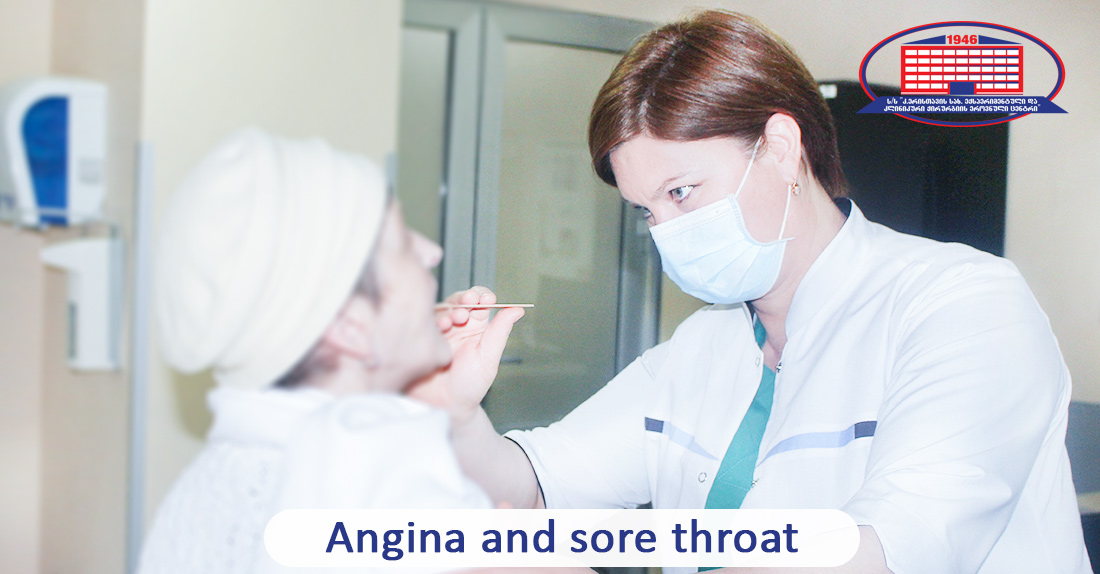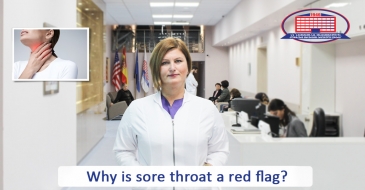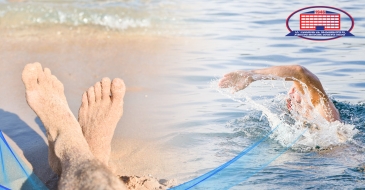
Angina (acute tonsillitis in medical terms) is an acute infectious disease.
In the interview, you will be informed about the following:
Commonly, sore throat is one of those symptoms that the patient rarely visits the clinic for, and in most cases tries to self-treat or doesn’t treat at all.
Seemingly usual symptom, discomfort common during cold days of winter, can be an indicator for various diseases or lead to such diseases as acute tonsillitis; It primarily progresses with palatine tonsil injury. Rarely damages nasopharyngeal or lingual tonsils, voice box (larynx) and circumesophageal ring.
What is angina
In medical practice, the term "angina" refers to palatine tonsil disease, but when the other tonsils are damaged, “tonsil” is added in the name. In this particular interview, we will discuss acute tonsillitis.
Oto-rhino-laryngologist of National Center of Surgery, Rusudan Kontselidze discusses the topic.
–What symptoms does angina present with?
– It presents with:
- Severe pain when swallowing;
- Difficulty swallowing;
- Frequent salivation;
- Depending on intoxication: general weakness, headache, joint pain, chills, fever (up to 38-39 degrees).
For reference, children of preschool and school-age, also adults up to 40 years old get sick more often.
Of course, it’s much easier to catch a cold during autumn-winter season, also, bacterial and viral infections easily affect the weakened body of children and adults. Weather variability in spring and vitamin deficiency should be taken into an account. Isolated cases occur in summer.
– What is the difference between angina and sore throat?
– Commonly, unlike the usual sore throat, the pain is much more intense, it’s difficult to swallow, the general condition deteriorates and body temperature increases (up to 38-39 degrees) in this pathology.
– What should we know about the causes?
– The most frequent causes are staphylococcus and streptococcus bacteria (especially group A beta-hemolytic) and pneumococcus. A more rare cause is viral and fungal etiology.
– What can you tell us about the incubation period?
–In viral etiology, the incubation period is 1-6 days, the contagious period is 1-2 days before the symptoms and 3 weeks after the onset of symptoms
In streptococcus etiology, the incubation period lasts from 12 hours to 4 days, the contagious period is 24 hours after the start of antibiotic therapy or 7 days after the disappearance of symptoms in case of antibiotic weren't used. Moreover, the risk of infection for a family member is approximately 25%.
On average, the duration of the disease is 7 days.
– What are the modes of transmission?
– There are 2 modes of transmission: exogenous and endogenous (autoinfection, i.e. self-infection).
Airborne and alimentary (through food) are exogenous.
Endogenous infection occurs through oral cavity and throat (for example chronic inflammation of palatine tonsil, tooth decay (cavities)). Contributing factors are general and local cold.
–What can you tell us about the types of disease?
– Clinicians group disease in vulgar (banal) and atypical (rare) types.
The following types are distinguished: I- catarrhal, II- follicular, III- lacunar, IV – fibrinous, V – herpetic, VI - phlegmonous, VII – ulcerative-necrotic (gangrenous), VIII – mixed type.
The following are frequent among the banal type: catarrhal, follicular and lacunar.
Catarrhal type is characterized by relatively mild progression.
In follicular, suppurated follicles of tonsils are present, tonsillar tissue is damaged more severely compared to catarrhal type.
Primary sign of lacunar is yellow patches (pus) on tonsillar lacunae.
Atypical types are ulcerative-necrotic inflammation, developed in systemic blood diseases and leukemia and/or herpetic and fungal diseases.
– What dangerous complications can develop?
–A complication can be general or local. General complications might present itself in streptococcal infections, in particular:
- Rheumatic fever that manifests in 2-3 weeks after the initial pathology, damages heart valves and muscles (myocarditis);
- Septic arthritis – joint inflammation;
- Acute glomerulonephritis (renal pathology) that manifests in 1-2 weeks after the initial acute tonsillitis.
Among local complications, attention should be paid to:
- Peritonsillar abscess (pus spreads to tissues surrounding palatine tonsils);
- Acute otitis (inflammation of the ear);
- Acute laryngitis (inflammation of the larynx)
- Swollen larynx;
- Acute cervical lymphadenitis (inflammation of lymph glands);
- Mediastinitis (pus spread in mediastinum).
– When to see a doctor?
– You should see a doctor if despite the self-treatment (mouth rinses, cough sweets, antipyretic drugs) sore throat doesn’t alleviate, swallowing and general condition (headache, joint pain, chills, high temperature) worsens.
Commonly, it’s necessary to include antibiotics in treatment. Duration and type of antibiotics are decided by a doctor. You should see an oto-rhino laryngologist to prevent severe complications.
It’s not recommended to take antibiotics without a doctor's recommendation!
Severe sore throat is a symptom of not only angina but also can be a sign of diseases such as infectious mononucleosis, scarlet fever, diphtheria, leukemia.
– What can you tell us about diagnostics?
– Comprehensive medical history is essential for reaching an accurate diagnosis. I conduct appropriate instrumental (pharyngoscopy) and laboratory (throat swab culture, antistreptolysin O titer, complete blood count) tests. Ultrasound imaging of soft tissue of the neck is ordered if necessary. I prescribe respective local and general treatment based on diagnostic studies and the patient's condition. Antibiotic therapy is ordered and the patient receives respective recommendations.
– What measures are recommended for prevention?
–Following is recommended for prevention:
- Strengthen immunity system through boosting measures (contrast shower, sip on cool beverages);
- Physical activity;
- Regular walks in the fresh air;
- Healthy nutrition comprising vitamins and microelements;
- Follow oral hygiene;
- Prompt elimination of oral and nasopharyngeal infectious area (cavities, sinusitis, otitis);
- Maximum distance from sick family members (use masks, air the room, clean the surface with wet materials);
- Frequently wash hands.
Wish you health!









